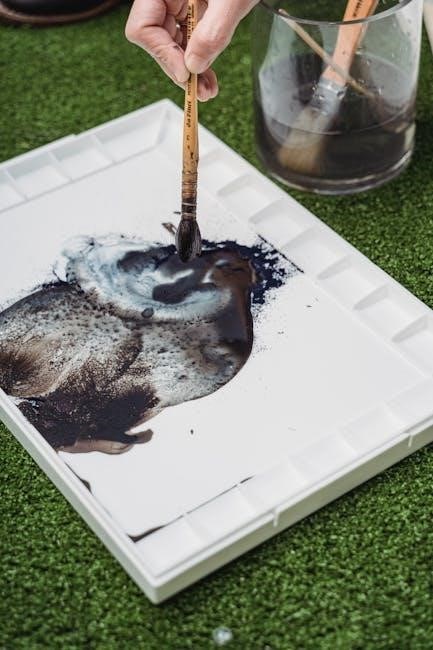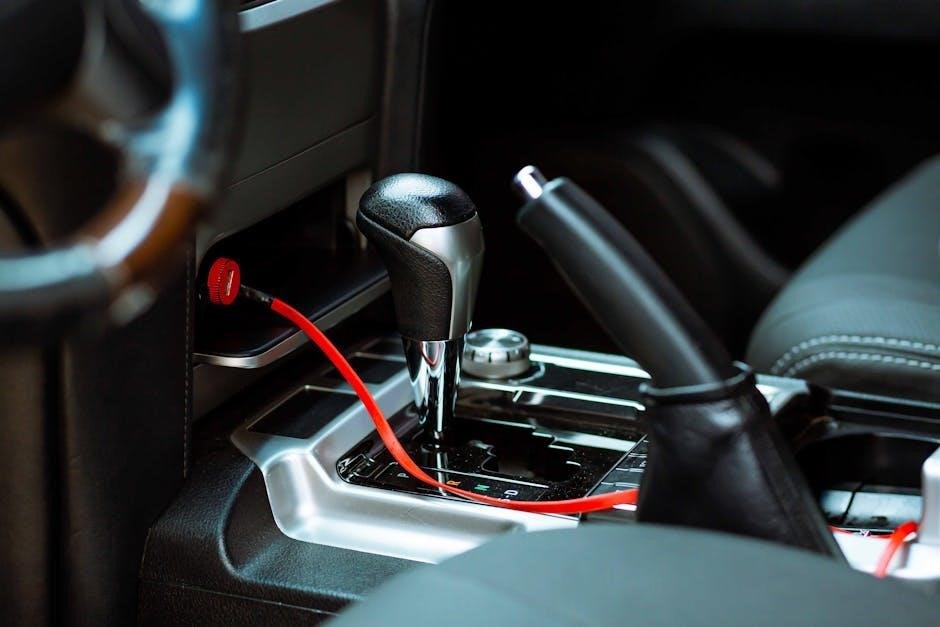Toyota manual transmission fluid is a high-performance lubricant essential for smooth gear operation, protecting components, and preventing overheating․ It’s specifically designed with a synthetic formula to meet Toyota’s stringent specifications․
Overview of Toyota Manual Transmission Fluid
Toyota manual transmission fluid is a specialized lubricant designed to ensure smooth operation of manual transmissions in Toyota vehicles․ It plays a critical role in reducing friction, preventing wear, and maintaining optimal gear performance․ Unlike automatic transmission fluid, manual transmission fluid is typically thinner and formulated to provide consistent lubrication under varying driving conditions․ Toyota recommends using a high-quality fluid that meets their specifications to ensure compatibility with transmission components․ The fluid helps in cooling the transmission, preventing overheating, and maintaining viscosity even in extreme temperatures․ Regular maintenance, including fluid checks and changes, is essential to extend the lifespan of the transmission and prevent costly repairs․ Toyota manual transmission fluid is engineered to deliver durability and reliability, making it a vital component for the overall performance of the vehicle․

Importance of Transmission Fluid in Manual Transmissions
Transmission fluid is crucial for the smooth operation of manual transmissions in Toyota vehicles․ It serves as a lubricant, reducing friction between moving parts and preventing wear and tear․ The fluid also acts as a coolant, dissipating heat generated by the transmission to prevent overheating, which can damage internal components․ Additionally, it inhibits corrosion, protecting metal parts from degradation over time․ The fluid ensures smooth gear engagement by maintaining the appropriate viscosity, allowing gears to mesh without grinding or slipping․ Furthermore, it acts as a hydraulic medium, facilitating the engagement of clutches and bands in automatic transmissions, though its role in manual transmissions is more focused on lubrication․ Proper fluid levels are essential to prevent inadequate lubrication and potential damage․ Using the correct Toyota-approved fluid ensures compatibility and optimal performance, while regular fluid changes maintain the fluid’s effectiveness and protect the transmission from degradation due to heat, friction, and contamination․

Types of Transmission Fluid for Toyota Manual Transmissions

Toyota manual transmissions use specialized fluids like Toyota-approved synthetic blends or conventional oils, designed to meet specific viscosity and performance requirements for optimal lubrication and durability․
Toyota-Approved Transmission Fluid Specifications
Toyota manual transmissions require fluids that meet specific viscosity and performance standards to ensure optimal lubrication and protection․ The recommended fluid must comply with Toyota’s stringent specifications, which are designed to maintain smooth gear operation, prevent overheating, and protect against wear and tear․ Typically, Toyota-approved transmission fluids are high-quality synthetic blends that provide excellent thermal stability and shear resistance, ensuring consistent performance across varying driving conditions․ These fluids are formulated to minimize friction and extend the life of transmission components․ Using non-approved fluids can lead to reduced performance, increased wear, and potential damage to the transmission system․ Always refer to your vehicle’s owner’s manual or consult a Toyota service professional to ensure the correct fluid is used for your specific model and year․
Recommended Brands and Products for Toyota Manual Transmissions
For Toyota manual transmissions, selecting the right fluid is crucial for optimal performance․ Toyota Genuine Manual Transmission Fluid is the most recommended option, as it is specifically formulated to meet the manufacturer’s standards․ Other reputable brands, such as Red Line MT-90 and MT-85, are also widely recognized for their high-quality synthetic blends that provide excellent lubrication and wear protection․ Amsoil Manual Transmission Fluid and Valvoline Synthetic Manual Transmission Fluid are additional excellent choices, offering superior thermal stability and shear resistance․ These products are designed to maintain smooth gear engagement, prevent overheating, and extend the lifespan of the transmission․ Always consult the owner’s manual or a Toyota service professional to ensure the selected fluid is compatible with your specific vehicle model and year․

Checking the Transmission Fluid Level
Checking the transmission fluid level is a straightforward process․ Ensure the engine is warm, locate the dipstick, and pull it out to inspect the fluid level and condition․ Low levels may cause grinding gears or slipping, so maintaining the correct amount is essential for smooth operation and longevity․
Locating the Transmission Fluid Dipstick

Locating the transmission fluid dipstick in a Toyota manual transmission is essential for checking the fluid level․ For most Toyota models, the dipstick is located under the driver’s side of the vehicle, near the front of the car․ To access it, you may need to lift the vehicle slightly using a jack or ramps for better visibility․ The dipstick is typically labeled with a gear or “Transmission Fluid” marking․ If you’re unsure, consult your owner’s manual or look for guidance specific to your Toyota model․ Some models may have the dipstick positioned near the engine, while others might require reaching underneath the driver’s side tire․ Always ensure the vehicle is on level ground and the engine is warm for an accurate fluid level reading․
Steps to Check the Transmission Fluid Level
Warm Up the Engine: Start the engine and let it run for a few minutes to warm up the transmission fluid․ This ensures an accurate reading․
Locate the Dipstick: Find the transmission fluid dipstick, usually labeled and located under the driver’s side of the vehicle or near the front of the engine․
Check the Level: Pull out the dipstick and wipe it clean with a lint-free rag․ Insert it back fully, then pull it out again to get the current fluid level․
Inspect the Fluid: Look at the color and consistency of the fluid․ Clean fluid should be light in color and free of debris․ Dark or gritty fluid may indicate it needs changing․
Compare to the Manual: Use the markings on the dipstick to compare the fluid level to the recommended level in your Toyota manual․ Add fluid if necessary, following the manufacturer’s guidelines․
Understanding the Transmission Fluid Color and Consistency
The color and consistency of Toyota manual transmission fluid are critical indicators of its condition․ New fluid typically has a light amber or reddish color and a smooth, consistent texture․ Over time, the fluid may darken to a brown or black hue, indicating contamination or degradation․ A gritty or milky texture suggests moisture contamination or wear debris, which can damage the transmission․
If the fluid appears dark brown or black, it may be a sign that it needs to be changed․ Additionally, if the fluid has a burnt smell or visible particles, it indicates wear on the transmission components․ Always compare the fluid’s condition to the manufacturer’s guidelines to determine if a change is necessary․ Avoid driving if the fluid is severely degraded, as it can lead to premature transmission failure․ Regular inspection of the fluid’s color and consistency helps maintain optimal performance and longevity of the manual transmission․

When to Change the Transmission Fluid
Toyota recommends changing manual transmission fluid every 60,000–90,000 miles, or sooner if dark, smelly, or contaminated․ Signs include slipping gears, strange noises, and overheating․
Recommended Service Intervals for Toyota Manual Transmissions
Toyota typically recommends changing the manual transmission fluid every 60,000 to 90,000 miles, depending on driving conditions․ For standard driving, the higher end of this range is suitable․ However, for vehicles subjected to harsh conditions such as frequent stop-and-go traffic, towing, or extreme temperatures, the interval should be reduced to around 30,000 to 60,000 miles․ It’s important to consult the owner’s manual for model-specific recommendations, as some Toyotas may have slightly different guidelines․ Additionally, synthetic fluids may offer longer service intervals compared to conventional ones, but it’s best to adhere to Toyota’s specifications to ensure optimal performance and longevity of the transmission․ Regular checks for fluid color and consistency can also help determine if an earlier change is necessary;
Signs That Indicate the Need for a Transmission Fluid Change
If your Toyota manual transmission exhibits grinding or slipping gears, it may signal low or degraded fluid levels․ Noises during shifting, such as clunking or whining, can also indicate the need for a fluid change․ A burning smell or smoke suggests overheating due to insufficient lubrication․ Transmission leaks, visible as puddles under the vehicle, are another clear sign․ Additionally, slow or hesitant gear engagement, poor acceleration, or delayed shifting can point to worn-out fluid․ If the fluid appears dark, gritty, or has a burnt odor, it’s past its useful life․ Ignoring these signs can lead to costly repairs, so addressing them promptly is crucial for maintaining your transmission’s health and performance․

How to Change the Transmission Fluid
- Locate the transmission fluid dipstick and drain plug․
- Drain the old fluid into a pan using a wrench or socket․
- Replace the drain plug and pour in new, Toyota-approved fluid․
- Check the fluid level using the dipstick and ensure it’s at the recommended level․
- Dispose of the used fluid responsibly and clean up any spills․
Tools and Materials Needed for a Transmission Fluid Change
To perform a transmission fluid change on your Toyota, you’ll need specific tools and materials to ensure the process is done safely and effectively․
- A large drain pan to catch the old fluid․
- A socket wrench or ratchet set for removing the drain plug․
- New Toyota-approved manual transmission fluid․
- A fluid filler pump or funnel for refilling․
- Gloves and protective eyewear for safety․
- A torque wrench for tightening the drain plug properly․
- Optional: A cleaning rag and solvent for cleaning the drain plug area․
Having these tools and materials ready ensures a smooth and efficient fluid change process․
Step-by-Step Guide to Draining and Refilling Transmission Fluid

Draining and refilling the transmission fluid in your Toyota manual transmission is a straightforward process when done correctly․ Start by warming up the engine to ensure the fluid flows easily․ Locate the drain plug, typically found underneath the vehicle near the driver’s side tire․ Use a socket wrench to remove the plug and let the old fluid drain into a large pan․ Once fully drained, replace the plug and tighten it securely using a torque wrench․ Next, locate the filler plug and remove it to pour in the new Toyota-approved manual transmission fluid․ Use a funnel to prevent spills․ Fill the transmission according to the manufacturer’s specifications, then replace the filler plug․ Finally, check the fluid level by inserting your finger into the filler hole to ensure it’s at the correct level․ Dispose of the used fluid responsibly․

Tips for Maintaining Toyota Manual Transmission Fluid
Regularly inspect fluid levels, ensure proper warm-up before draining, and avoid overfilling․ Use Toyota-approved fluids to maintain performance and longevity, preventing premature wear and overheating issues․
Best Practices for Extending Transmission Fluid Life
To extend the life of Toyota manual transmission fluid, ensure regular inspections and maintain proper fluid levels․ Always warm up the engine before draining or refilling to prevent temperature-related damage․ Avoid overfilling, as this can lead to foaming and reduced lubrication efficiency․ Use only Toyota-approved transmission fluids, as they are specifically formulated to meet the manufacturer’s standards and protect against wear and overheating․ Additionally, avoid aggressive driving habits, such as rapid acceleration or excessive gear shifting, which can generate heat and degrade the fluid faster․ Regularly check for leaks and address them promptly to prevent contamination or low fluid levels․ By following these practices, you can maximize the lifespan of your transmission fluid and ensure optimal performance of your Toyota’s manual transmission system․
Common Mistakes to Avoid When Handling Transmission Fluid
When handling Toyota manual transmission fluid, there are several common mistakes to avoid․ One of the most critical errors is using non-approved transmission fluids, which can damage the transmission and void the warranty․ Overfilling the transmission is another mistake, as it can lead to foaming and reduced lubrication efficiency․ Additionally, improper draining procedures, such as neglecting to use a drain pan or failing to replace the gasket, can result in contamination or leaks․ Never drain the fluid without warming up the engine, as cold fluid may not drain completely․ Avoid using the wrong tools, as this can strip threads or damage components․ Lastly, never neglect to check for leaks after refilling or replacing the fluid․ By avoiding these mistakes, you can ensure the longevity and performance of your Toyota’s manual transmission system․
Maintaining the health of your Toyota’s manual transmission fluid is crucial for ensuring smooth gear operation, preventing damage, and extending the lifespan of your vehicle․ Regular checks, proper fluid levels, and timely changes are essential to avoid costly repairs․ Always use Toyota-approved transmission fluids to meet the manufacturer’s specifications, and avoid common mistakes like overfilling or using incorrect tools․ By following the recommended service intervals and paying attention to signs of fluid degradation, you can maintain optimal performance․ Remember, proper care of your manual transmission fluid is a simple yet critical step in keeping your Toyota running efficiently for years to come․ Consistent maintenance not only protects your investment but also ensures a safer and more enjoyable driving experience․